Prepare to transform your perception of vegetables with this incredible Oven-Roasted Cauliflower Recipe. What was once considered a humble and perhaps uninspiring vegetable is elevated to an irresistible culinary delight through the magic of roasting. My husband, a self-proclaimed picky eater, was utterly converted by this dish. The florets emerge from the oven beautifully caramelized, sweet, tender, and boasting a depth of flavor that’s truly addictive. It’s not uncommon for both of us to sneak a few tasty florets straight from the baking sheet before they even make it to the serving dish!
This method of **Oven-Roasted Cauliflower** perfectly enhances its natural sweetness, delivering a profoundly delicious side dish with rich, nutty, and buttery undertones. The simple addition of a few pantry staples turns an ordinary vegetable into a showstopper, making it a perfect accompaniment to almost any meal. Whether you’re a long-time cauliflower fan or looking to win over skeptics, this recipe promises to deliver outstanding results every time.
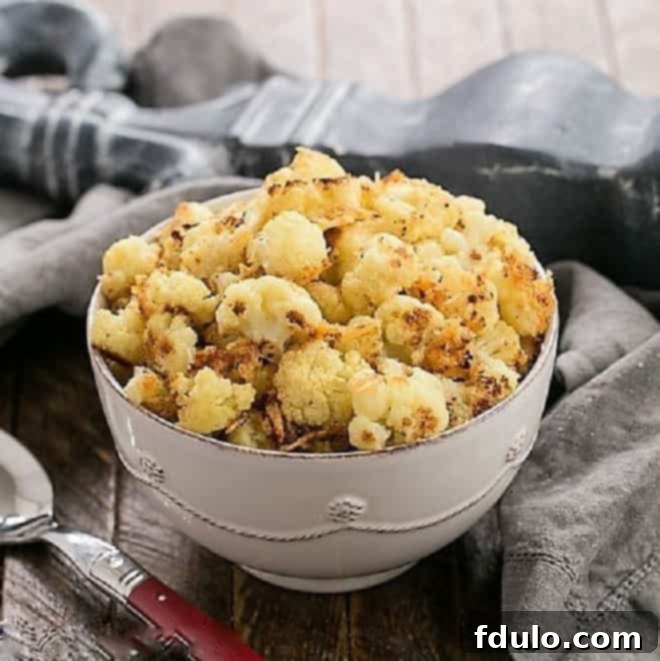
Why This Roasted Cauliflower Recipe Will Become Your Favorite
Many of you know the challenge of cooking for a picky palate. After nearly 35 years of marriage, I’ve slowly but surely introduced my husband to a variety of vegetables he once swore he disliked. From broccoli and asparagus to the occasional zucchini (which he still amusingly calls “cucumber”), and most recently, cauliflower – this particular roasting method has been a game-changer. It’s more than just a recipe; it’s a revelation that can transform even the most ardent vegetable skeptics into genuine fans.
- Picky Eater Approved: This exact roasting technique was the secret weapon that finally turned my husband into a cauliflower enthusiast. If it can win him over, it can certainly convert anyone! The caramelization creates an irresistible sweetness that makes it far more appealing than boiled or steamed cauliflower.
- Flavor Transformation: Roasting truly works wonders on cauliflower. The intense, dry heat of the oven causes the vegetable’s natural sugars to caramelize, creating a depth of flavor that is nutty, buttery, and inherently sweet. This process brings out a completely different character compared to other cooking methods.
- Simple Ingredients, Extraordinary Results: With just a few basic additions like fresh bread crumbs, grated Parmesan, olive oil, salt, and pepper, this simple recipe yields outrageously delicious results. These ingredients work in harmony in the oven to create a crispy, tender, and savory side dish that feels gourmet yet requires minimal effort.
- A Guaranteed Crowd-Pleaser: Beyond just picky eaters, this Roasted Cauliflower recipe has a universal appeal. It’s a fantastic way to introduce more vegetables into your family’s diet and is sure to become a staple side dish for weeknight dinners and special occasions alike. Prepare to see plates clean and requests for seconds!
- Nutrient-Rich and Delicious: Not only is this dish incredibly tasty, but it also packs a significant nutritional punch. Roasting helps retain many of cauliflower’s beneficial vitamins and minerals, making it a healthy choice you’ll actually look forward to eating.
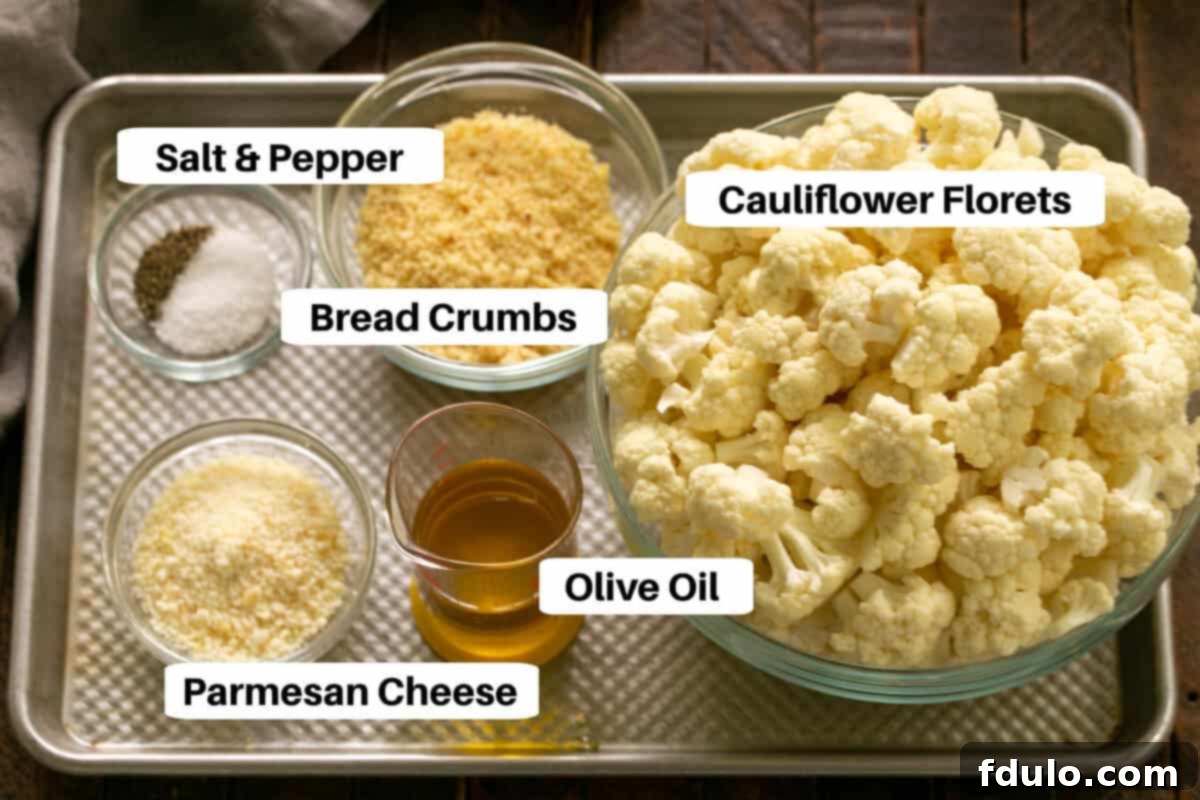
Essential Ingredient Notes for Perfect Roasted Cauliflower
While the beauty of this roasted cauliflower recipe lies in its simplicity, using quality ingredients and understanding their role can elevate your dish from good to absolutely phenomenal. Here’s a closer look at what you’ll need and some tips for selection:
- Kitchen Staples:
- Salt: Kosher salt is preferred for its coarser texture and easier control over seasoning.
- Freshly Ground Black Pepper: Always opt for freshly ground pepper; it offers a far more aromatic and robust flavor compared to pre-ground versions.
- Olive Oil: A good quality extra virgin olive oil is key. It not only coats the florets for crisping but also imparts a delicious, fruity flavor. Choose an olive oil you enjoy the taste of on its own.
- Cauliflower: Select a firm, white head of cauliflower with tight florets and fresh, green leaves. Avoid any heads with brown spots or a soft texture, as these indicate it’s past its prime. Cut the cauliflower into uniformly sized bite-sized florets, roughly ½ to 1 inch. Uniformity is crucial for even cooking and consistent caramelization. You can save any excess core or stems for soups, stocks, or cauliflower rice, minimizing waste.
- Parmesan Cheese: This is where quality truly makes a difference. Insist on using real Parmigiano Reggiano, freshly grated if possible. The pre-grated Parmesan in the green canister, while convenient, lacks the nuanced, salty, and nutty flavor of authentic Parmigiano. Freshly grated cheese melts beautifully and contributes significantly to the savory crust.
- Bread Crumbs: For the best texture and flavor, homemade breadcrumbs are highly recommended. Simply save crusts and ends from sliced bread loaves, dry them out (either air-dry overnight or lightly toast in the oven), and then pulse them in a food processor until fine. Store them in a sealed Ziploc bag in your freezer for freshness. If using store-bought breadcrumbs, opt for plain, unseasoned varieties to control the flavor profile yourself. Panko breadcrumbs also work wonderfully for extra crispiness.

Expert Tips for Perfectly Roasted Cauliflower Every Time
Achieving perfectly tender and beautifully caramelized roasted cauliflower is simple with a few insider tricks. I’ve learned these nuances over many years of cooking, and they will help ensure your first and every subsequent attempt is utterly delicious and perfectly crisp, not soggy.
- Uniform Floret Size is Key: Cut your cauliflower into small, uniform florets, ideally between ½ to 1-inch pieces. Consistency in size ensures that all pieces cook evenly and brown at the same rate. Larger pieces might remain raw in the center, while smaller ones could burn. Don’t be afraid to discard the tougher core and thick stems, or save them for another purpose.
- PRO-Tip: Ensure Florets are Dry: This is perhaps the most crucial tip for crispy roasted vegetables. Wash your cauliflower head ahead of time, then allow the florets to dry completely. You can pat them thoroughly with paper towels or even use a salad spinner. Oil won’t adhere well to damp florets, and excess moisture will cause the cauliflower to steam instead of roast, resulting in a soggy texture.
- Thorough Coating with Oil: Place the dried florets in a large mixing bowl. Add the olive oil and toss vigorously to ensure every single piece is evenly coated. While it means one extra bowl to clean, this step is vital for maximum crispiness and flavor. Then, add the Parmesan and bread crumbs and toss again until well distributed. This ensures each floret gets a delicious, savory crust.
- PRO-Tip: Don’t Crowd the Pan: Use a large, rimmed baking sheet (or two, if necessary) to spread the cauliflower florets in a single layer without overcrowding. When florets are too close together, they release moisture, which gets trapped and turns into steam. This steam prevents browning and caramelization, leading to mushy cauliflower. Give them space to breathe and roast properly.
- Season Thoughtfully: Sprinkle the florets with kosher salt and freshly ground pepper before roasting. Remember that Parmesan cheese is naturally salty, so adjust your salt addition accordingly to avoid over-salting. However, don’t skip the salt entirely, as it’s essential for enhancing the overall flavor.
- PRO-Tip: Roast at High Heat: For the best caramelization and crispy texture, roast your cauliflower at a high temperature, typically between 400°F and 450°F (200°C to 230°C). High heat encourages browning on the exterior while cooking the interior until tender. Lower temperatures might cook the cauliflower but won’t give you that desirable golden, crispy finish.
- Toss Halfway Through: About halfway through the cooking time, take a moment to toss the cauliflower florets. This ensures that as much surface area as possible comes into contact with the hot baking sheet, promoting even browning and crispiness on all sides.
The Remarkable Nutritional Benefits of Cauliflower
We all understand that vegetables are fundamental for a healthy diet, and a plate rich in fruits and veggies is always recommended. But have you ever stopped to consider the specific, impressive health benefits that cauliflower brings to the table? This versatile cruciferous vegetable is a powerhouse of nutrition, and when prepared deliciously, like this roasted version, it’s easy to incorporate into your regular meals.
- High in Fiber: Cauliflower is an excellent source of dietary fiber, with approximately 3 grams in every cup. Fiber is crucial for digestive health, helping to prevent constipation and promote regularity. It also contributes to satiety, helping you feel full and satisfied, which can be beneficial for weight management. While raw cauliflower might not be everyone’s favorite, the sweet, tender florets of roasted cauliflower make getting your fiber intake a true pleasure!
- Rich in Essential Nutrients: This humble vegetable is packed with an impressive array of vitamins and minerals. It’s particularly high in Vitamin C, an antioxidant vital for immune function and skin health. It’s also a significant source of Folate (Vitamin B9), which is essential for cell growth and function, Vitamin K, important for blood clotting and bone health, as well as B6, Magnesium, Potassium, and Manganese.
- Contains Choline: Cauliflower is one of the few plant sources of Choline, an essential nutrient vital for various bodily functions. Choline plays a crucial role in brain health, particularly in memory and learning, as well as in muscle control and metabolism. Including cauliflower in your diet is a delicious way to support cognitive function.
- Packed with Antioxidants: This cruciferous superstar is brimming with antioxidants, including glucosinolates and isothiocyanates. These compounds help combat oxidative stress by neutralizing harmful free radicals in the body. By reducing free radical damage, antioxidants can help decrease inflammation and potentially offer protective benefits against chronic diseases, including certain types of cancer.
- Supports Weight Loss: Cauliflower is a fantastic ally for weight management. It’s naturally low in calories and carbohydrates, making it an excellent substitute for higher-carb foods. For example, cauliflower rice is a popular and tasty low-carb alternative to traditional rice. Its high fiber and water content help to fill you up, promoting a feeling of fullness and helping to minimize overeating, making it a valuable addition to any weight loss journey.
How to Make This Simple Roasted Cauliflower
Follow these visual steps to prepare your perfect batch of roasted cauliflower. The process is straightforward, ensuring delicious results even for novice cooks. For detailed instructions, refer to the recipe card below.
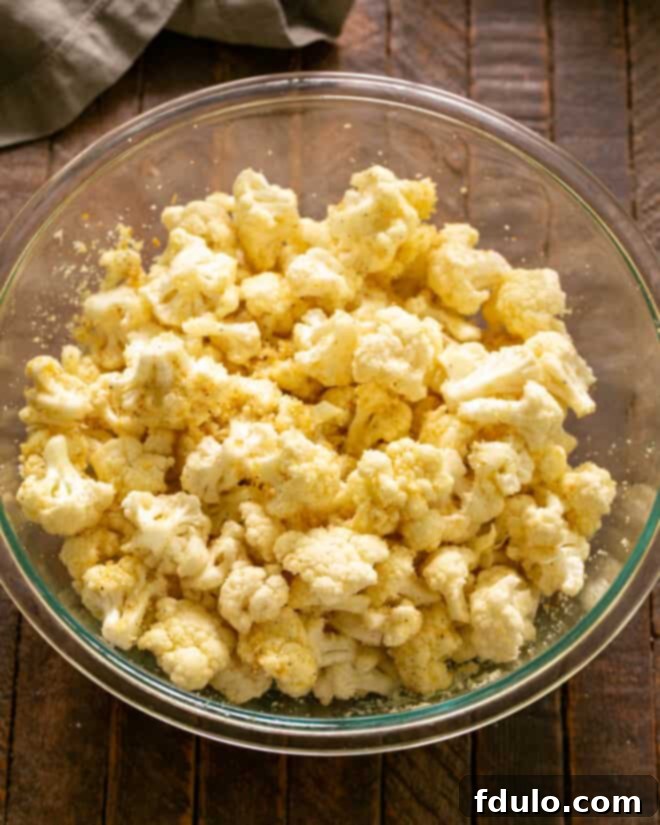
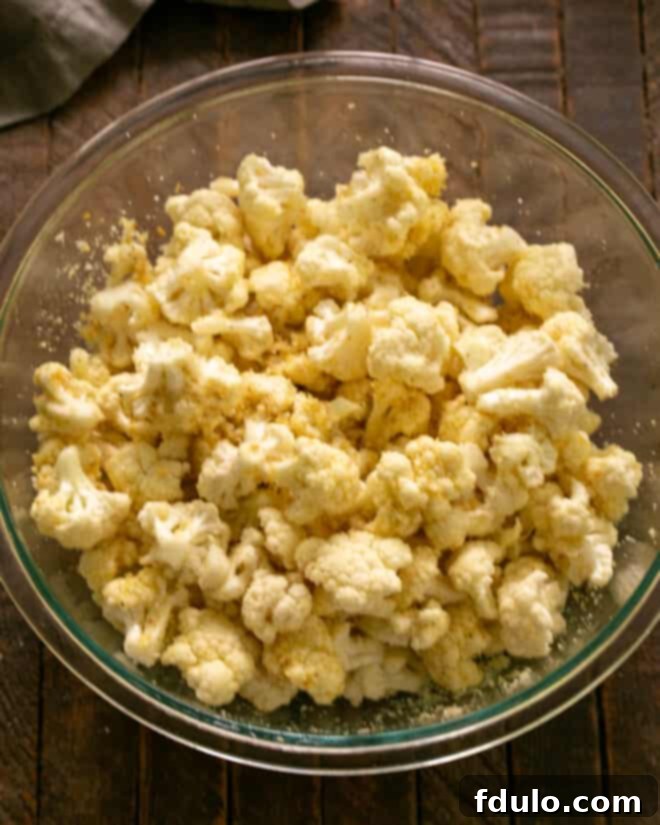
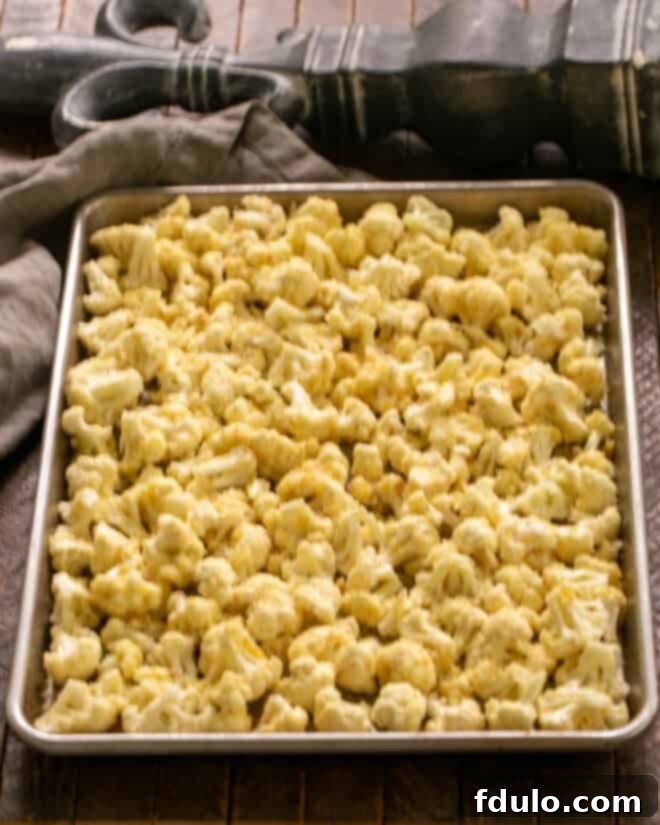
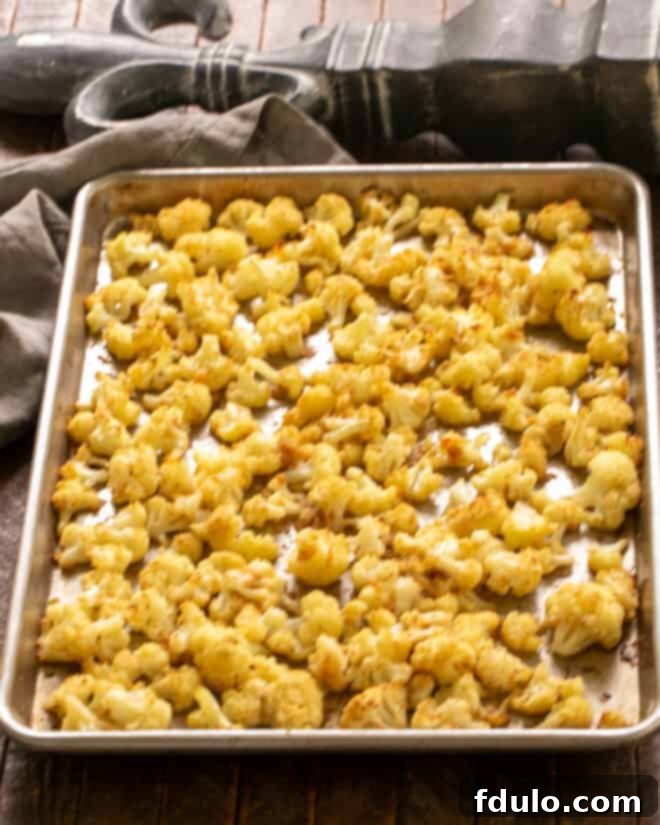
Frequently Asked Questions About Roasted Cauliflower
Yes, you absolutely can roast frozen cauliflower, but for the best results, roast it directly from its frozen state without defrosting first. This approach helps minimize steaming and encourages better browning. However, you won’t be able to apply the bread crumb and Parmesan toppings as effectively, as they won’t stick well to the icy florets. While fresh cauliflower is always preferred for its superior texture and ability to absorb flavors, frozen cauliflower works wonderfully in a pinch, especially if you’re looking for a quick and simple roasted vegetable side.
At our house, the quickest way to reheat roasted cauliflower is in the microwave. However, if you’re aiming to restore some of that delicious crispiness, a better option is to sauté the leftovers in a skillet on the stovetop over medium heat for a few minutes until warmed through and lightly re-crisped. Alternatively, you can spread it on a baking sheet and reheat it in a preheated oven at 375°F (190°C) for about 5-10 minutes, which will also help bring back some of its initial crunch.
Roasted cauliflower itself is naturally very low in carbohydrates. If you prepare your cauliflower with just olive oil and Parmesan cheese, it remains an excellent low-carb option, making it suitable for keto or low-carb diets. However, once you add bread crumbs, the carbohydrate content per serving will increase. For a strictly low-carb version, simply omit the bread crumbs or substitute them with finely crushed pork rinds or almond flour for a similar texture.
You can certainly freeze simple roasted cauliflower that has been prepared without any toppings. To do so, let it cool completely, then spread it in a single layer on a baking sheet and freeze until solid before transferring to an airtight freezer bag. However, this particular version, which includes bread crumbs and Parmesan, would not defrost well. The bread crumbs tend to get soggy and lose their appealing texture once frozen and thawed, making this specific recipe best enjoyed fresh.
Store any leftover roasted cauliflower in an airtight container in the refrigerator for up to 3-4 days. While it’s best enjoyed fresh, it makes for a delicious addition to salads, bowls, or as a quick side dish for subsequent meals.
Absolutely! While this recipe is fantastic as is, feel free to experiment with additional seasonings. A sprinkle of garlic powder, onion powder, paprika, or even a pinch of red pepper flakes can add extra depth and a little kick. Fresh herbs like parsley or thyme can also be added after roasting for a fresh burst of flavor.
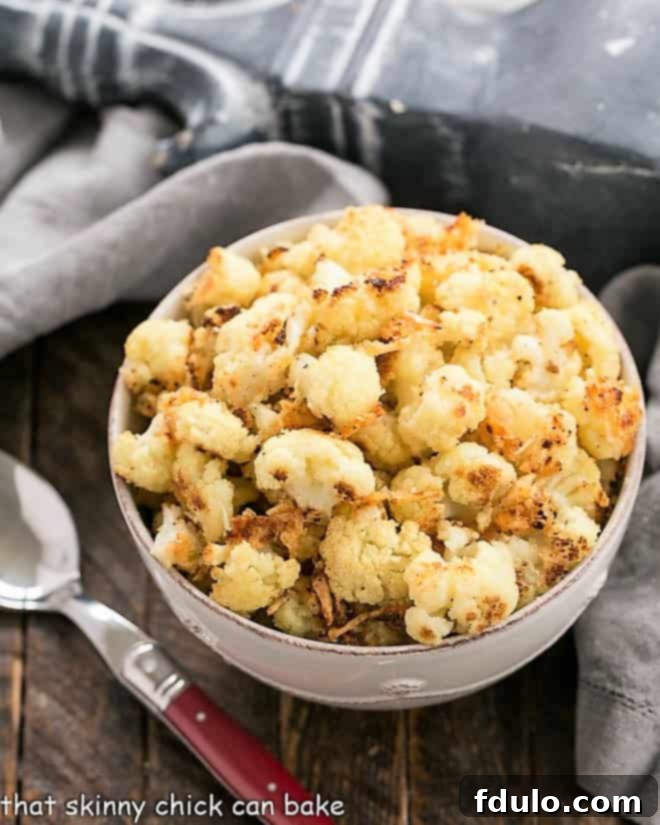
Explore More Delicious Side Dish Recipes
If you’ve fallen in love with this roasted cauliflower, you’ll be delighted to know that there are many other incredible vegetable dishes to explore. For a heartier cauliflower dish that also received my husband’s coveted seal of approval, be sure to check out this Cauliflower Bacon Gratin.
- Parmesan Roasted Carrots from Your Homebased Mom – Sweet and savory, these carrots are simple yet elegant.
- Pesto Roasted Brussels Sprouts from Aggie’s Kitchen – A flavorful twist on a classic roasted vegetable.
- Roasted Asparagus with Balsamic Brown Butter – A sophisticated side with rich, tangy notes.
- Cheesy Vegetable Tian – Layers of thinly sliced vegetables baked with gooey cheese.
- Green Bean and Bacon Bundles – An impressive and tasty side for any gathering.
- Oven Roasted Green Beans – Crispy, garlicky, and utterly addictive green beans.
- Honey Roasted Carrots – A sweet and vibrant side that’s always a hit.
- Discover even more delightful Side Dish Recipes to complement your meals.
Stay in touch through social media @ Instagram, Facebook, and Pinterest. Don’t forget to tag me when you try one of my recipes! And if you love the results, please give it a 5-star rating in the recipe card below – your feedback means the world!

Perfectly Roasted Cauliflower with Parmesan and Crispy Bread Crumbs
10 minutes
30-40 minutes
40-50 minutes
4-6 servings
This easy Roasted Cauliflower with Parmesan and Bread Crumbs transforms a simple vegetable into a delicious, caramelized, and irresistible side dish that even the pickiest eaters will adore!
Ingredients
- 1 medium head cauliflower (about 2-2.5 lbs), cut into ½ to 1-inch florets, thoroughly dried.
- ½ cup fresh bread crumbs (homemade or panko for best results)
- ¼ cup freshly grated Parmigiano Reggiano cheese
- ¼ cup extra virgin olive oil
- ½ teaspoon kosher salt, or to taste
- ¼ teaspoon freshly ground black pepper, or to taste
Instructions
- Preheat your oven to 400ºF (200ºC). This high heat is essential for achieving caramelization.
- In a large mixing bowl, toss the dried cauliflower florets with the olive oil until every piece is evenly coated. Then, add the bread crumbs and freshly grated Parmesan cheese, tossing again thoroughly to ensure a good distribution of toppings.
- Spread the coated cauliflower florets out in a single layer over a large, rimmed baking sheet. It’s crucial that the florets are not overcrowded; use two baking sheets if necessary to prevent steaming and encourage proper roasting and browning. Season evenly with kosher salt and freshly ground black pepper.
- Roast for 30-40 minutes, flipping the cauliflower florets halfway through the cooking time to ensure even browning. Continue roasting until the cauliflower is fork-tender inside and beautifully golden brown and caramelized on the edges.
Notes
Do not crowd the cauliflower on the baking sheet, or the florets will steam instead of roast, resulting in a soft, rather than crispy, texture. Use multiple sheets if needed.
Servings will vary from 4-6 depending on the size of your cauliflower head and individual portion sizes.
For an extra kick, a pinch of red pepper flakes can be added along with the salt and pepper before roasting.
Recommended Products
As an Amazon Associate and member of other affiliate programs, I earn from qualifying purchases.
- Black Spatula
- OXO Cutting Board
- USA Pan Bakeware Half Sheet Pan
Nutrition Information:
Yield:
6
Serving Size:
1
Amount Per Serving (approximate):
Calories: 154Total Fat: 11gSaturated Fat: 2gTrans Fat: 0gUnsaturated Fat: 8gCholesterol: 4mgSodium: 204mgCarbohydrates: 11gFiber: 3gSugar: 3gProtein: 4g
Thatskinnychickcanbake.com occasionally offers nutritional information for recipes contained on this site. This information is provided as a courtesy and is an estimate only. This information comes from online calculators. Although thatskinnychickcanbake.com attempts to provide accurate nutritional information, these figures are only estimates.
Varying factors such as product types or brands purchased can change the nutritional information in any given recipe. Also, many recipes on thatskinnychickcanbake.com recommend toppings, which may or may not be listed as optional and nutritional information for these added toppings is not listed. Other factors may change the nutritional information such as when the salt amount is listed “to taste,” it is not calculated into the recipe as the amount will vary. Also, different online calculators can provide different results.
To obtain the most accurate representation of the nutritional information in any given recipe, you should calculate the nutritional information with the actual ingredients used in your recipe. You are solely responsible for ensuring that any nutritional information obtained is accurate.
HOW MUCH DID YOU LOVE THIS RECIPE?
Please leave a comment on the blog or share a photo on Pinterest and tag us!
